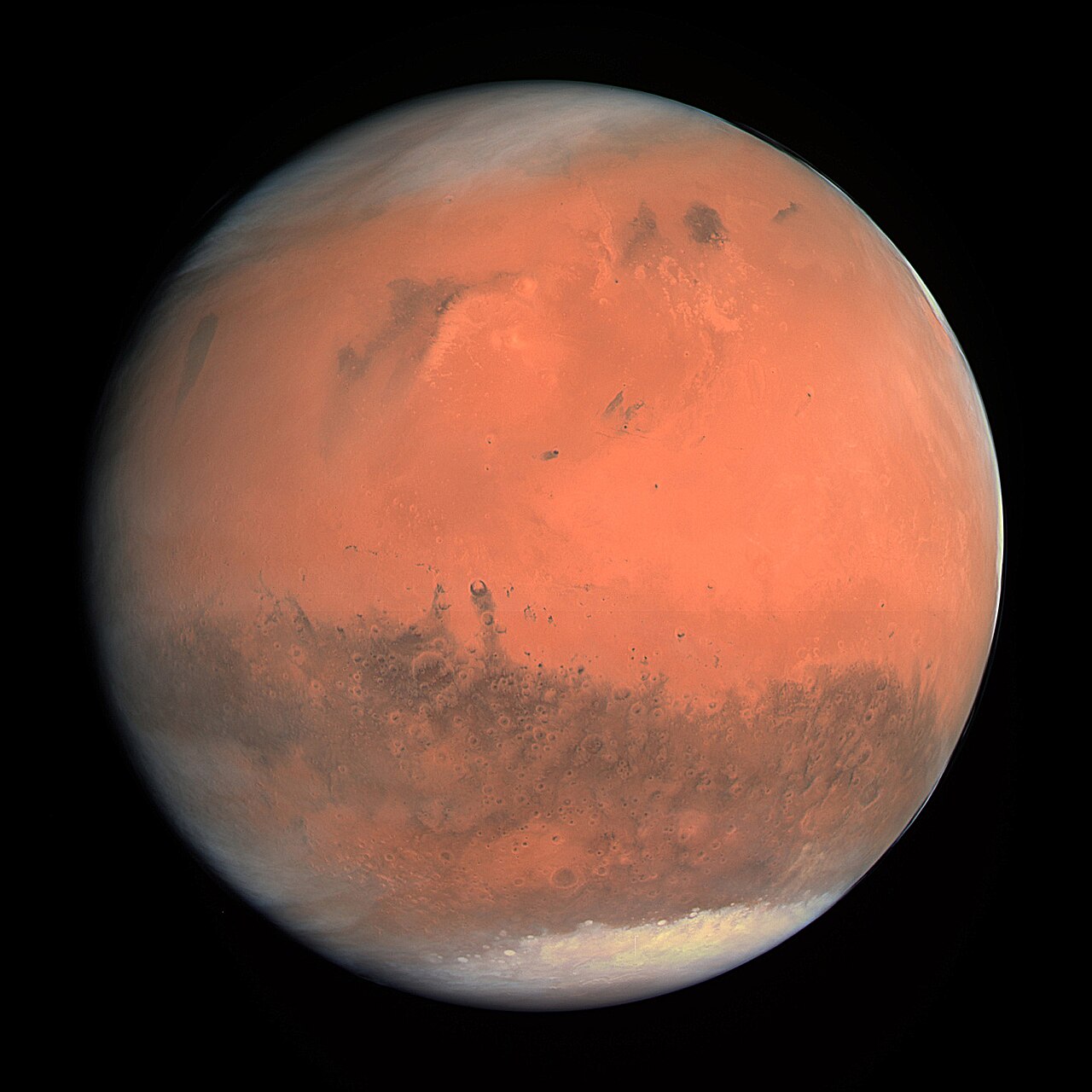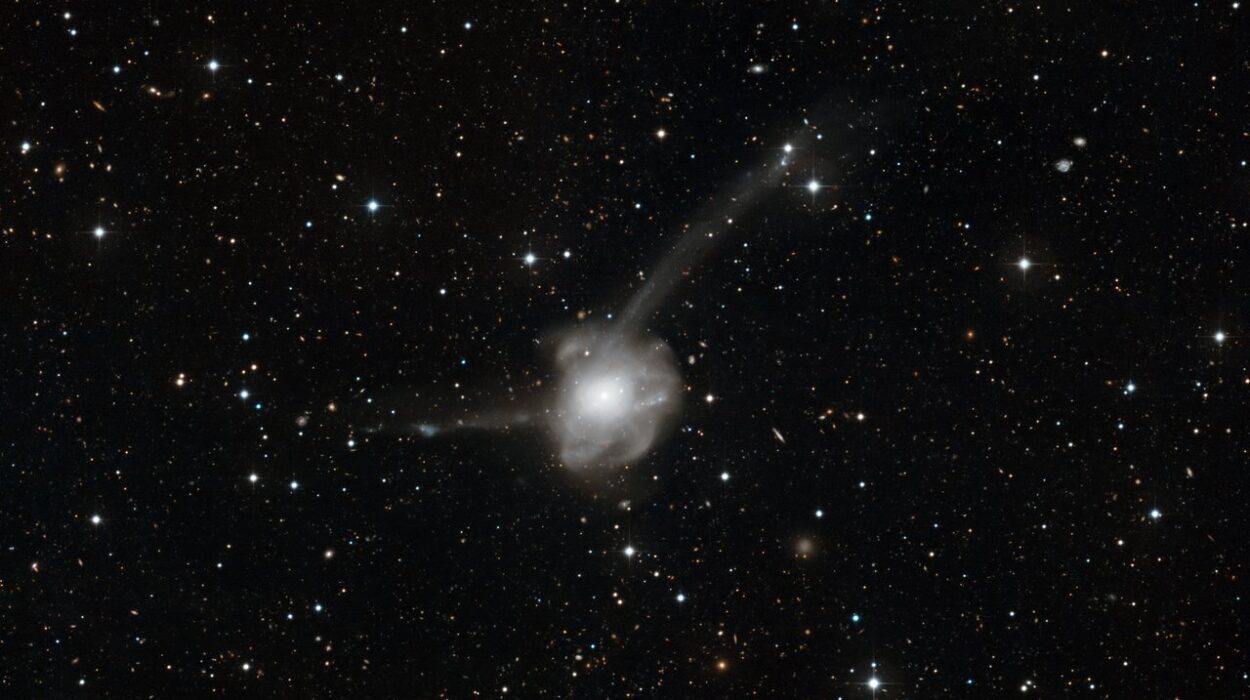Mars has captivated human imagination for centuries, glowing like a mysterious ember in the night sky. Its reddish hue has earned it the nickname “the Red Planet,” inspiring myths of fire gods and stories of alien civilizations. But beneath that iconic color lies a world of scientific complexity—a planet shaped by ancient volcanoes, vast dust storms, and billions of years of chemical transformation. Understanding why Mars is red requires delving deep into its geology, atmosphere, and planetary history. The redness of Mars is not a superficial characteristic; it is the signature of a dynamic and evolving planet, one that has recorded in its rust-colored surface the story of its past.
The Mystery of the Red Planet
When early astronomers gazed at Mars, they were struck by its vivid color. Ancient Egyptians called it “Her Desher,” meaning “the Red One.” The Babylonians associated it with Nergal, the god of war and destruction. Later, the Romans named it after their own god of war, Mars, because its bloodlike hue evoked images of conflict and energy. But for all its mythic associations, the redness of Mars has a purely scientific explanation rooted in chemistry and geology.
Unlike Earth, whose surface is largely blue and green due to oceans and vegetation, Mars is dominated by iron-rich minerals that have undergone oxidation—essentially, they have rusted. The planet’s surface is coated with a layer of fine dust and rock fragments rich in iron oxide, which reflects sunlight in the red and orange wavelengths. The same process that causes iron to rust on Earth has turned Mars into a planetary canvas of crimson and ochre.
However, understanding why Mars is red goes far beyond surface rust. The planet’s mineral composition, atmospheric conditions, and geological history have all played a role in shaping its unique appearance.
The Chemistry of Martian Color
At the heart of Mars’ redness lies a simple but powerful chemical process: oxidation. On Earth, iron exposed to oxygen and moisture forms iron oxide, commonly known as rust. Mars, too, contains abundant iron within its crust, but the oxidation process there operates differently because of the planet’s distinct environment.
The Martian surface is dominated by iron-bearing minerals like magnetite (Fe₃O₄) and hematite (Fe₂O₃). Hematite, in particular, gives the soil its reddish tint. Over billions of years, ultraviolet radiation, thin atmospheric oxygen, and perhaps traces of water vapor combined to oxidize these iron minerals. As a result, the surface became coated in a fine layer of iron oxide dust.
The dust is so pervasive that it fills the atmosphere, giving the entire planet a reddish-brown hue even from orbit. During sunsets on Mars, the sky glows blue because the fine red dust scatters sunlight in unique ways, the opposite of Earth’s blue sky and red sunsets. This interplay between light and mineral dust gives Mars its otherworldly beauty.
Interestingly, not all of Mars is red. Satellite imagery shows patches of darker regions where the underlying basaltic rock is exposed, untouched by the pervasive oxidized dust. These darker areas—like Syrtis Major and Mare Erythraeum—are volcanic plains composed of fresh basalt, revealing what Mars might look like beneath its oxidized blanket.
Iron: The Element That Painted Mars
Iron is one of the most abundant elements in the universe, forged in the hearts of massive stars and scattered across space in supernova explosions. When Mars formed roughly 4.6 billion years ago, it inherited a generous portion of iron during the accretion of rocky material. The planet’s crust and mantle became infused with iron-bearing minerals similar to those on Earth.
However, the difference lies in how that iron evolved. On Earth, the continuous cycling of materials through plate tectonics, volcanic activity, and biological processes keeps much of the iron locked within rocks or dissolved in the oceans. Mars, by contrast, is geologically quieter. Without plate tectonics or active recycling, iron minerals on its surface remained exposed to the environment for billions of years. Over time, they reacted with trace amounts of oxygen and water vapor to produce iron oxides.
The planet’s low atmospheric pressure and lack of liquid water slowed the oxidation process compared to Earthly rusting, but ultraviolet radiation from the Sun provided energy to drive the reactions. As these surface minerals weathered, winds ground them into microscopic dust particles, which now cover the planet in a fine, iron-rich powder.
Geological Foundations of a Red World
The story of Mars’ color is inseparable from its geology. The Martian surface bears the scars of volcanic eruptions, asteroid impacts, ancient river valleys, and wind erosion. Each geological process has contributed to redistributing and exposing the iron minerals that define the planet’s reddish tone.
Mars’ crust is primarily basaltic, similar to volcanic rock on Earth. This basalt is naturally rich in iron and magnesium. In the early epochs of Martian history, particularly during the Noachian period around 4 billion years ago, massive volcanic activity released lava that solidified into vast basaltic plains. Over time, these rocks were fractured and weathered by wind and, possibly, flowing water.
The presence of ancient river valleys and delta formations, discovered by orbiters like Mars Reconnaissance Orbiter and rovers such as Curiosity and Perseverance, suggests that water once played an active role in shaping the landscape. As liquid water interacted with basaltic rocks, it accelerated the chemical weathering that produced iron oxides and clay minerals. These materials were then transported and deposited across wide regions, leaving behind reddish sedimentary layers.
The planet’s immense volcanoes—Olympus Mons, Arsia Mons, Pavonis Mons, and Ascraeus Mons—also played a major role. These volcanic systems produced enormous quantities of ash and lava, spreading iron-bearing material across the surface. Later, erosion and oxidation turned much of this volcanic residue into fine dust.
The Dust That Never Settles
One of the most defining features of Mars today is its ever-present dust. The planet’s thin atmosphere and weak gravity allow dust particles to remain suspended for long periods, enveloping the planet in a reddish haze. These particles are incredibly fine—smaller than talcum powder—and composed largely of silicates, sulfates, and iron oxides.
Global dust storms are a recurring phenomenon on Mars. Unlike anything on Earth, these storms can engulf the entire planet for weeks or even months. During such events, dust lifted into the atmosphere scatters sunlight, giving Mars its characteristic reddish glow when viewed from space. The 2018 planet-wide dust storm, for example, was so intense that it temporarily ended the mission of NASA’s Opportunity rover by blocking sunlight from its solar panels.
The persistence of this dust layer means that every exposed surface—rocks, craters, and even spacecraft—is eventually coated in iron oxide. The entire Martian landscape is thus unified under a thin veil of rust-colored powder, renewing the planet’s red appearance even after local disturbances.
The Role of Water in Shaping Mars’ Surface
Water may have been the key ingredient that transformed Mars from a dark volcanic world into a red planet. Although today Mars is cold and arid, geological evidence suggests that it once hosted rivers, lakes, and perhaps even shallow seas.
When liquid water interacted with basaltic rock, it triggered oxidation reactions similar to those that occur when iron rusts on Earth. Water acted as both a solvent and a catalyst, breaking down minerals and releasing iron ions that later combined with oxygen to form iron oxides like hematite and goethite. Over millions of years, these oxidized minerals accumulated on the surface, creating layers of red sedimentary rock.
Orbital spectrometers have detected hydrated minerals—clays and sulfates—that can only form in the presence of water. Regions such as Meridiani Planum, explored by the Opportunity rover, contain spherical hematite nodules known as “blueberries,” formed by precipitation in ancient groundwater. These mineralogical clues confirm that water once played a vital role in the planet’s oxidative transformation.
However, as Mars lost much of its atmosphere, surface water gradually evaporated or froze. Without the protective pressure and warmth of a thick atmosphere, the planet’s surface became desiccated, leaving behind the rusty residue of its wetter past.
Atmospheric Influence on Martian Color
Mars’ atmosphere, though thin, contributes significantly to its red appearance. Composed primarily of carbon dioxide with traces of nitrogen, argon, and oxygen, it interacts constantly with the dusty surface. The perpetual circulation of fine particles gives the sky its orange or salmon tint.
Sunlight scattering through the Martian atmosphere produces colors that differ from Earth’s. Because the air is filled with iron oxide dust, shorter wavelengths like blue light are scattered differently, allowing reddish hues to dominate. The result is a daytime sky that appears butterscotch or pinkish, while sunsets turn deep blue as the dust refracts sunlight at low angles.
The thin atmosphere also lacks an ozone layer, allowing intense ultraviolet radiation to reach the surface. This radiation not only oxidizes iron minerals directly but also breaks down water molecules in the upper atmosphere. The hydrogen escapes into space, while the oxygen contributes to surface oxidation processes over geological timescales.
Thus, the same atmosphere that makes Mars appear red also perpetuates the oxidation cycle that maintains its color.
Volcanic History and Surface Composition
Mars’ geological history is dominated by volcanic activity. Some of the largest volcanoes in the solar system reside on Mars, with Olympus Mons rising nearly three times higher than Mount Everest. These immense volcanic eruptions released vast quantities of iron-rich lava and gases into the environment, laying the foundation for the planet’s mineral composition.
Basaltic lava from these volcanoes cooled into iron- and magnesium-rich rocks. Later, through mechanical weathering by wind and temperature fluctuations, these rocks broke down into smaller fragments. Over time, their surfaces oxidized, producing the fine red dust that now coats the planet.
Volcanic gases, including water vapor and carbon dioxide, may have briefly thickened the atmosphere in ancient times, creating conditions conducive to chemical reactions between iron minerals and oxidants. Some scientists propose that sulfur released from volcanic activity also contributed to the formation of sulfates and other minerals that influence the surface’s coloration.
The extensive volcanic plains of Tharsis and Elysium remain key regions for studying the connection between volcanic processes and Mars’ global redness. They reveal how planetary-scale eruptions helped distribute iron-bearing materials across the surface, setting the stage for oxidation on a planetary scale.
Planetary Weathering and Wind Erosion
Mars is a desert world, but its winds are far from gentle. Even though the atmosphere is thin, wind erosion is one of the most powerful forces shaping the Martian surface today. Over billions of years, high-velocity winds have blasted rock surfaces with dust particles, grinding them down and distributing oxidized material across vast distances.
This process, known as aeolian erosion, continually refreshes the planet’s reddish appearance. As the wind strips darker basaltic rocks, it exposes fresh material that quickly oxidizes. The same winds lift oxidized dust into the air, spreading it globally.
Dune fields across the planet, such as those in the Gale Crater and Nili Patera, reveal layers of differently colored sand—some darker, some more reddish. These variations offer clues to the balance between freshly exposed volcanic material and older oxidized sediments. Over time, the constant abrasion and redistribution of dust reinforce the planet’s uniform red hue.
The Influence of Time and Planetary Evolution
Mars’ redness is not a temporary feature—it is the product of billions of years of planetary evolution. In its youth, Mars was likely darker, its surface dominated by black basalt and gray volcanic plains. Only through the slow accumulation of oxidized dust and the influence of water and radiation did it gradually transform into the red world we see today.
The oxidation of iron on Mars occurred over immense timescales, shaped by cycles of volcanic activity, atmospheric loss, and climatic change. During the early Noachian era, abundant water and a thicker atmosphere may have supported rapid oxidation. Later, as the planet cooled and dried, oxidation continued more slowly through exposure to ultraviolet radiation and chemical reactions involving peroxides and superoxides produced in the thin atmosphere.
The result is a planet whose surface chemistry has reached equilibrium with its environment. The red dust continually cycles between the surface and the atmosphere, ensuring that even as new craters form or rocks fracture, the overall appearance remains consistently red.
Insights from Mars Rovers and Orbiters
Modern exploration has transformed our understanding of why Mars is red. Spacecraft such as NASA’s Mars Global Surveyor, Mars Reconnaissance Orbiter, and the European Space Agency’s Mars Express have mapped the planet’s mineral composition in extraordinary detail. Rovers like Spirit, Opportunity, Curiosity, and Perseverance have conducted on-the-ground analyses of rocks, soils, and atmospheric dust.
Spirit and Opportunity found compelling evidence of past water interactions, discovering hematite-rich areas and sulfate deposits formed in aqueous environments. Curiosity’s instruments detected variations in iron oxidation states within different sedimentary layers, revealing how environmental conditions changed over time. Perseverance, currently exploring the Jezero Crater, is investigating delta deposits that may contain remnants of ancient lakes, further linking water to surface oxidation.
These findings confirm that Mars’ redness is not just a superficial coating but a window into its chemical and climatic evolution. The red dust tells a story of transformation—from a wetter, volcanic planet to the cold, oxidized desert we see today.
Beyond the Color: What Red Reveals About Habitability
The same processes that gave Mars its red hue also have implications for its potential to harbor life. On Earth, iron-oxidizing bacteria play a role in rust formation, suggesting that oxidation can coexist with biological activity. However, the extreme dryness, radiation, and oxidizing chemistry of modern Mars create a hostile surface environment for life as we know it.
Yet, the presence of iron oxides does not rule out the possibility of life entirely. In fact, iron-rich minerals can preserve microbial fossils and organic molecules. Beneath the oxidized surface, protected from radiation, more neutral or reducing conditions might exist, where traces of past life could be found. The Perseverance rover’s mission to collect and cache samples for future return to Earth aims to uncover precisely such evidence.
Thus, the redness of Mars, while symbolizing desolation, may also conceal clues to its biological past. Understanding how and why the planet became red helps scientists reconstruct its environmental timeline and assess its potential habitability in ancient epochs.
Mars and Earth: A Tale of Divergence
Both Mars and Earth began as rocky planets with similar building blocks, yet their evolutionary paths diverged dramatically. On Earth, a magnetic field, plate tectonics, and a thick atmosphere preserved oceans and moderated climate. On Mars, the early loss of its magnetic field allowed solar wind to strip away the atmosphere, cooling the planet and drying its surface.
As the atmosphere thinned, surface water disappeared, and oxidation became the dominant force shaping surface chemistry. The red planet we see today is thus a snapshot of a frozen world that once might have been blue. Its iron oxides are relics of that transformation—a permanent mark of what the planet once was.
Studying Mars helps scientists understand how planetary environments evolve and what conditions are necessary to sustain habitability. The comparison also offers a cautionary perspective on planetary fragility and climate change.
The Symbolism and Science of Mars’ Redness
Mars’ color has influenced human culture as much as it has informed science. For millennia, its red light inspired myths of war, energy, and transformation. Today, that same color serves as a scientific beacon, guiding exploration and discovery. The redness of Mars symbolizes both its alien beauty and its familiarity—after all, rust is something we know well on Earth.
In scientific terms, the red color is the visible evidence of invisible forces: oxidation, weathering, and time. It represents a bridge between chemistry and planetary history, connecting microscopic mineral changes to global atmospheric evolution. Each grain of red dust is a record of ancient sunlight, water, and air.
As humanity prepares to send astronauts to Mars in the coming decades, understanding its surface chemistry will be crucial not only for science but also for survival. The red dust, while beautiful, poses challenges to equipment and health; it clings to everything and may contain reactive compounds. But it also holds resources—iron, oxygen, and water-bearing minerals—that future explorers can harness.
Conclusion
The redness of Mars is not a simple matter of color but a profound reflection of its nature. It is the outcome of a complex interplay between iron-rich geology, atmospheric processes, water chemistry, and time. Iron atoms forged in ancient stars now define the appearance of an entire world, turned to rust by eons of exposure to thin air and solar radiation.
To ask why Mars is red is to ask about its history—its volcanic origins, its watery past, and its atmospheric decline. The iron oxides that coat its surface are both the signature of oxidation and the residue of lost habitability. They speak of a planet that once had the conditions for change, perhaps even for life, but has since settled into stillness.
Yet the story is not over. The red planet continues to evolve, its dust storms reshaping the surface, its winds painting new patterns across ancient plains. In studying its color, humanity glimpses not only the chemistry of another world but also the universal processes that bind all planets together. Mars is red because it has lived, aged, and transformed—and in that transformation, it reflects the dynamic beauty of the cosmos itself.






